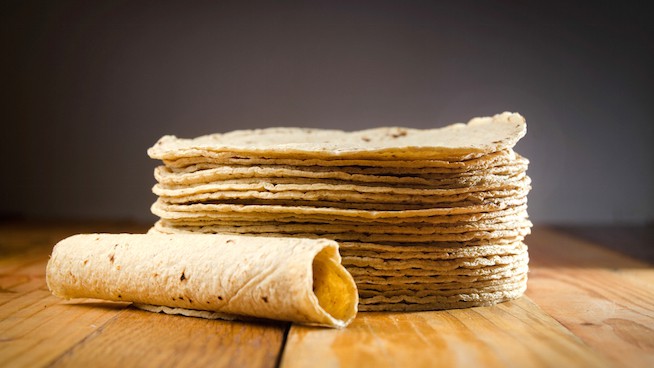Is Chipotle Actually Healthy?
For many people, Chipotle is like a second home.
The fast casual restaurant chain now has more than 2,000 locations, a testament to its popularity. Chipotle’s food is fresh, tasty and (relatively) fast. What’s not to like? There’s also the fact that despite their quick turnaround times, Chipotle feels markedly healthier than traditional fast food. But there can be a big difference between perception and reality. When you dig into the nutrition facts, is Chipotle really healthier than a typical drive-thru order from McDonald’s or Burger King? STACK investigates.
The Spice of Life

Tortillas and taco on wood table
If you’re looking for a black-and-white, yes-or-no answer on whether Chipotle is healthy, you’re out of luck. Why? Because Chipotle’s menu offers too much variety to paint it with broad strokes. Both of the following meals are typical examples of what a customer might order at Chipotle (nutrition facts via Chipotle.com Nutrition Calculator):
Meal A: 1,270 calories, 51.5 total grams fat, 22 grams saturated fat, 3,365mg sodium, 20.5 grams fiber, 9.5 grams sugar, 60.5 grams protein
Meal B: 650 calories, 21.5 total grams fat, 9 grams saturated fat, 1,380mg sodium, 17 grams fiber, 4.5 grams sugar, 50 grams protein
Obviously, meal A is much more problematic than meal B. Its saturated fat and sodium content is roughly equivalent to what you’d find in three Big Macs. Meal B is much more well-rounded, offering a tremendous amount of protein and fiber but with a more manageable amount of calories and fat.
Here’s what’s inside both those orders. Meal A is a burrito. The ingredients are one flour tortilla, chorizo, white rice, pinto beans, fajita veggies, corn salsa, hot salsa, sour cream and cheese. Meal B is a burrito bowl. The ingredients are chicken, brown rice, black beans, fajita veggies, green-chili salsa and cheese.
You want to know the biggest difference between meal A and meal B? The tortilla, cheese and sour cream. Meal A has all three of them. Meal B has just cheese. At the end of the day, those three ingredients can make or break the health of your Chipotle meal.
A handful of cheese might not seem like much, but a serving of shredded cheese from Chipotle contains 100 calories and 5 grams of saturated fat. That’s roughly the same amount of saturated fat in a Snickers bar. The American Heart Association recommends that no more than 6 percent of your daily calories come from saturated fats. Saturated fats can raise your bad cholesterol and put you at a higher risk for heart disease. A serving of sour cream at Chipotle packs 115 calories, 9 grams of fat and 7 grams of saturated fat. Most of Chipotle’s employees have a pretty heavy hand with the sour cream, so I wouldn’t be surprised if the actual serving is even larger. Nonetheless, that’s almost as much saturated fat as you’d get from a McDonald’s Hot Fudge Sundae. A flour tortilla from Chipotle contains 300 calories, 10 grams of fat, one gram of saturated fat and 690 grams of sodium. That’s about as many calories and carbs as you’d find in six Chips Ahoy! cookies, and as much sodium as you’d get from six pretzel rods. The smaller tortillas used for tacos have similar nutrition facts—save for the soft corn tortillas, which are low in fat and sodium.
All told, the cheese, sour cream and flour tortilla in meal A combine for 515 calories, 26.5 grams of fat, 13 grams of saturated fat and 910mg of sodium. Yikes. Besides cheese, sour cream and tortillas, the foods available at Chipotle are mostly healthy. It’s basically just meat, rice, beans and various veggies, all of which are nutritionally dense. This is why the vast majority of Chipotle meals are high in fiber, protein and antioxidants.
One other ingredient that people may get concerned about is guacamole. Chipotle’s guacamole might look fairly unhealthy due to its high fat content, but this is one of those rare cases where a food is actually healthier than its raw nutrition facts. Avocados are the main ingredient in guacamole, and they’re packed with antioxidants, fiber and healthy monounsaturated fat. In moderation, monounsaturated fats help to reduce blood pressure and protect against heart disease. They can also help the body better absorb vitamins and more efficiently use protein. Chipotle’s guacamole is best used as a healthier substitute for their sour cream and/or cheese.
However, even a “healthy meal” at Chipotle can still have one red flag—sodium.
Sodium Shock

Salt spilling on wooden table from salt cellar
Chipotle heavily seasons much of their food, which has a big impact on sodium content. When you bring several of these foods together into the same dish, the sodium total can skyrocket.
The Dietary Guidelines for Americans recommend that adults and children over the age of 14 should limit sodium intake to less than 2,300 mg per day—about what you find in one teaspoon of table salt. (Note: While many equate salt with sodium, sodium is in fact a component of salt. Table salt is about 40 percent sodium; the rest is chloride.) Although athletes who work out at a high intensity for hours a day can and should consume more, people who work out only moderately (for an hour or less per day) typically don’t sweat enough to warrant a high-sodium diet. According to estimates, the average American consumes 3,400 mg of sodium a day—more than twice the recommended amount. Studies show that 9 in 10 Americans consume too much sodium. Over-consuming sodium can lead to high blood pressure, heart failure, stroke and a wide range of other issues. Health officials estimate that if Americans lowered their daily sodium intake to the recommended range, it would prevent up to 92,000 deaths annually.
Keeping the sodium in your Chipotle meal to a manageable level is easier if you’re aware of the biggest offenders. Here are some of the most high-sodium ingredients on Chipotle’s menu:
- Flour Tortilla (Burrito), 690mg
- Soft Flour Tortillas (Tacos), 570mg
- Barbacoa, 530mg
- Chorizo, 810mg
- Sofritas, 555mg
- Tomato Salsa, 550mg
- Tomatillo Red-Chili Salsa (a.k.a “Hot”), 500mg
- Vinaigrette, 850mg
In terms of meat, barbacoa, sofritas and chorizo all have more than 530 mg of sodium per serving. Chorizo actually contains a whopping 810 mg of sodium per serving. Both brown rice and white rice aren’t bad, but brown rice does have 150 mg less sodium per serving. The salsas can get you in trouble. Avoid the “hot” salsa (actually named Tomatillo Red-Chili Salsa) and the fresh tomato salsa if you’re looking to reduce sodium, as both come in at 500 mg+ per serving. The salad vinaigrette is actually the most sodium-packed ingredient on the entire menu, coming in at 850 mg of sodium per serving. It also packs 25 grams of fat, so it’s certainly best used sparingly.
The Verdict

Chipotle Mexican Grill Inc. take-out food is arranged for a photograph in Tiskilwa, Illinois, U.S., on Friday, April 22, 2016. Chipotle Mexican Grill Inc. is expected to release earnings figures on April 26. Photographer: Daniel Acker/Bloomberg
Chipotle can be as healthy—or as unhealthy—as you want to make it. The Nutrition Calculator available on their website is an excellent resource. Toy around with it for a while and you’ll get a sense of what ingredients should—and should not—be regular additions to your meals.
If you’re a person who gets a tortilla, cheese and sour cream every time you go to Chipotle, it’s worth thinking about making some changes. Perhaps try to get just one of those three ingredients, or substitute guacamole. Such decisions may seem trivial, but they can make a world of difference from a nutritional standpoint. Same goes for the sodium content. If you know what ingredients pack the most sodium, you can avoid them and keep the levels somewhat manageable.
At Chipotle, a little bit of restraint can go a long way.
READ MORE:
RECOMMENDED FOR YOU
Is Chipotle Actually Healthy?
For many people, Chipotle is like a second home.
The fast casual restaurant chain now has more than 2,000 locations, a testament to its popularity. Chipotle’s food is fresh, tasty and (relatively) fast. What’s not to like? There’s also the fact that despite their quick turnaround times, Chipotle feels markedly healthier than traditional fast food. But there can be a big difference between perception and reality. When you dig into the nutrition facts, is Chipotle really healthier than a typical drive-thru order from McDonald’s or Burger King? STACK investigates.
The Spice of Life

Tortillas and taco on wood table
If you’re looking for a black-and-white, yes-or-no answer on whether Chipotle is healthy, you’re out of luck. Why? Because Chipotle’s menu offers too much variety to paint it with broad strokes. Both of the following meals are typical examples of what a customer might order at Chipotle (nutrition facts via Chipotle.com Nutrition Calculator):
Meal A: 1,270 calories, 51.5 total grams fat, 22 grams saturated fat, 3,365mg sodium, 20.5 grams fiber, 9.5 grams sugar, 60.5 grams protein
Meal B: 650 calories, 21.5 total grams fat, 9 grams saturated fat, 1,380mg sodium, 17 grams fiber, 4.5 grams sugar, 50 grams protein
Obviously, meal A is much more problematic than meal B. Its saturated fat and sodium content is roughly equivalent to what you’d find in three Big Macs. Meal B is much more well-rounded, offering a tremendous amount of protein and fiber but with a more manageable amount of calories and fat.
Here’s what’s inside both those orders. Meal A is a burrito. The ingredients are one flour tortilla, chorizo, white rice, pinto beans, fajita veggies, corn salsa, hot salsa, sour cream and cheese. Meal B is a burrito bowl. The ingredients are chicken, brown rice, black beans, fajita veggies, green-chili salsa and cheese.
You want to know the biggest difference between meal A and meal B? The tortilla, cheese and sour cream. Meal A has all three of them. Meal B has just cheese. At the end of the day, those three ingredients can make or break the health of your Chipotle meal.
A handful of cheese might not seem like much, but a serving of shredded cheese from Chipotle contains 100 calories and 5 grams of saturated fat. That’s roughly the same amount of saturated fat in a Snickers bar. The American Heart Association recommends that no more than 6 percent of your daily calories come from saturated fats. Saturated fats can raise your bad cholesterol and put you at a higher risk for heart disease. A serving of sour cream at Chipotle packs 115 calories, 9 grams of fat and 7 grams of saturated fat. Most of Chipotle’s employees have a pretty heavy hand with the sour cream, so I wouldn’t be surprised if the actual serving is even larger. Nonetheless, that’s almost as much saturated fat as you’d get from a McDonald’s Hot Fudge Sundae. A flour tortilla from Chipotle contains 300 calories, 10 grams of fat, one gram of saturated fat and 690 grams of sodium. That’s about as many calories and carbs as you’d find in six Chips Ahoy! cookies, and as much sodium as you’d get from six pretzel rods. The smaller tortillas used for tacos have similar nutrition facts—save for the soft corn tortillas, which are low in fat and sodium.
All told, the cheese, sour cream and flour tortilla in meal A combine for 515 calories, 26.5 grams of fat, 13 grams of saturated fat and 910mg of sodium. Yikes. Besides cheese, sour cream and tortillas, the foods available at Chipotle are mostly healthy. It’s basically just meat, rice, beans and various veggies, all of which are nutritionally dense. This is why the vast majority of Chipotle meals are high in fiber, protein and antioxidants.
One other ingredient that people may get concerned about is guacamole. Chipotle’s guacamole might look fairly unhealthy due to its high fat content, but this is one of those rare cases where a food is actually healthier than its raw nutrition facts. Avocados are the main ingredient in guacamole, and they’re packed with antioxidants, fiber and healthy monounsaturated fat. In moderation, monounsaturated fats help to reduce blood pressure and protect against heart disease. They can also help the body better absorb vitamins and more efficiently use protein. Chipotle’s guacamole is best used as a healthier substitute for their sour cream and/or cheese.
However, even a “healthy meal” at Chipotle can still have one red flag—sodium.
Sodium Shock

Salt spilling on wooden table from salt cellar
Chipotle heavily seasons much of their food, which has a big impact on sodium content. When you bring several of these foods together into the same dish, the sodium total can skyrocket.
The Dietary Guidelines for Americans recommend that adults and children over the age of 14 should limit sodium intake to less than 2,300 mg per day—about what you find in one teaspoon of table salt. (Note: While many equate salt with sodium, sodium is in fact a component of salt. Table salt is about 40 percent sodium; the rest is chloride.) Although athletes who work out at a high intensity for hours a day can and should consume more, people who work out only moderately (for an hour or less per day) typically don’t sweat enough to warrant a high-sodium diet. According to estimates, the average American consumes 3,400 mg of sodium a day—more than twice the recommended amount. Studies show that 9 in 10 Americans consume too much sodium. Over-consuming sodium can lead to high blood pressure, heart failure, stroke and a wide range of other issues. Health officials estimate that if Americans lowered their daily sodium intake to the recommended range, it would prevent up to 92,000 deaths annually.
Keeping the sodium in your Chipotle meal to a manageable level is easier if you’re aware of the biggest offenders. Here are some of the most high-sodium ingredients on Chipotle’s menu:
- Flour Tortilla (Burrito), 690mg
- Soft Flour Tortillas (Tacos), 570mg
- Barbacoa, 530mg
- Chorizo, 810mg
- Sofritas, 555mg
- Tomato Salsa, 550mg
- Tomatillo Red-Chili Salsa (a.k.a “Hot”), 500mg
- Vinaigrette, 850mg
In terms of meat, barbacoa, sofritas and chorizo all have more than 530 mg of sodium per serving. Chorizo actually contains a whopping 810 mg of sodium per serving. Both brown rice and white rice aren’t bad, but brown rice does have 150 mg less sodium per serving. The salsas can get you in trouble. Avoid the “hot” salsa (actually named Tomatillo Red-Chili Salsa) and the fresh tomato salsa if you’re looking to reduce sodium, as both come in at 500 mg+ per serving. The salad vinaigrette is actually the most sodium-packed ingredient on the entire menu, coming in at 850 mg of sodium per serving. It also packs 25 grams of fat, so it’s certainly best used sparingly.
The Verdict

Chipotle Mexican Grill Inc. take-out food is arranged for a photograph in Tiskilwa, Illinois, U.S., on Friday, April 22, 2016. Chipotle Mexican Grill Inc. is expected to release earnings figures on April 26. Photographer: Daniel Acker/Bloomberg
Chipotle can be as healthy—or as unhealthy—as you want to make it. The Nutrition Calculator available on their website is an excellent resource. Toy around with it for a while and you’ll get a sense of what ingredients should—and should not—be regular additions to your meals.
If you’re a person who gets a tortilla, cheese and sour cream every time you go to Chipotle, it’s worth thinking about making some changes. Perhaps try to get just one of those three ingredients, or substitute guacamole. Such decisions may seem trivial, but they can make a world of difference from a nutritional standpoint. Same goes for the sodium content. If you know what ingredients pack the most sodium, you can avoid them and keep the levels somewhat manageable.
At Chipotle, a little bit of restraint can go a long way.
READ MORE:










